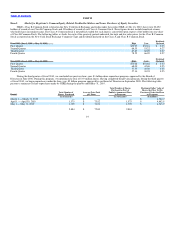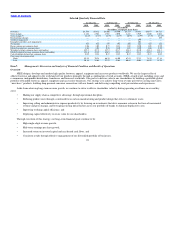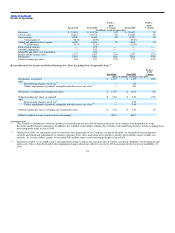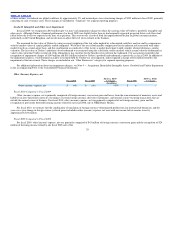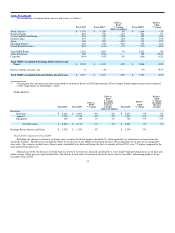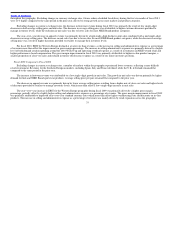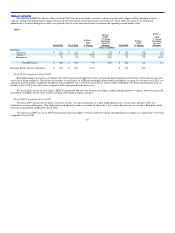Nike 2010 Annual Report Download - page 32
Download and view the complete annual report
Please find page 32 of the 2010 Nike annual report below. You can navigate through the pages in the report by either clicking on the pages listed below, or by using the keyword search tool below to find specific information within the annual report.
Table of Contents
NIKE Bauer Hockey business. For fiscal 2008, other (income) expense, net was primarily comprised of a $32 million gain on the sale of NIKE Bauer
Hockey and a $29 million gain on the sale of the Starter brand business, as well as foreign currency conversion losses of $77 million.
For fiscal 2009, we estimate that the combination of translation of foreign currency−denominated profits from our international businesses and the
year−over−year change in foreign currency related gains and losses included in other (income) expense, net increased our income before income taxes by
approximately $124 million.
Income Taxes
Fiscal 2010 Fiscal 2009 FY10 vs. FY09
% Change Fiscal 2008 FY09 vs. FY08
% Change
Effective tax rate 24.2% 24.0% 20 bps 24.8% (80) bps
Fiscal 2010 Compared to Fiscal 2009
Our effective tax rate for fiscal 2010 was 20 basis points higher than the effective rate for fiscal 2009. Our effective tax rate for fiscal 2009 includes a
tax benefit related to charges recorded for the impairment of Umbro’s goodwill, intangible and other assets. Excluding this tax benefit, our effective rate for
fiscal 2009 would have been 26.5%, 230 basis points higher than our effective tax rate for fiscal 2010. The decrease in our effective tax rate for fiscal 2010
was primarily attributable to the continued benefit from our international operations, where tax rates for these operations are generally lower than the U.S.
statutory rate.
We estimate that our effective tax rate for fiscal year 2011 will be in line with our fiscal 2010 effective tax rate.
Fiscal 2009 Compared to Fiscal 2008
Our effective tax rate for fiscal 2009 was 80 basis points lower than the effective tax rate for fiscal 2008 due primarily to the tax benefit related to the
impairment of goodwill, intangible and other assets of Umbro which had a favorable impact of 250 basis points. Profits earned outside of the U.S., the
impact of the resolution of foreign audit items and the retroactive reinstatement of the research and development tax credit also favorably impacted our
fiscal 2009 effective tax rate. Reflected in the effective tax rate for fiscal 2008 was a one−time tax benefit of $105 million, which had a favorable impact of
420 basis points on our effective tax rate.
Operating Segments
As part of the restructuring initiative that took place in fiscal 2009, the Company changed the geographic structure of NIKE Brand to six geographies
to streamline its management structure, enhance consumer focus, drive innovation more quickly to market and establish a more scalable cost structure.
Effective June 1, 2009, the Company’s new reportable operating segments for the NIKE Brand became: North America, Western Europe, Central and
Eastern Europe, Greater China, Japan, and Emerging Markets. Previously, NIKE Brand operations were organized into four regions: U.S., Europe, Middle
East and Africa (collectively, “EMEA”), Asia Pacific, and Americas.
As part of our centrally managed foreign exchange risk management program, standard foreign currency rates are assigned to each NIKE Brand entity
in our geographic operating segments and are used to record any non−functional currency revenues or product purchases into the entity’s functional
currency. Geographic operating segment revenues and cost of sales reflect use of these standard rates. For all NIKE Brand operating segments, differences
between assigned standard foreign currency rates and actual market rates are included in Corporate together with foreign currency hedge gains and losses
generated from the centrally managed foreign
29


